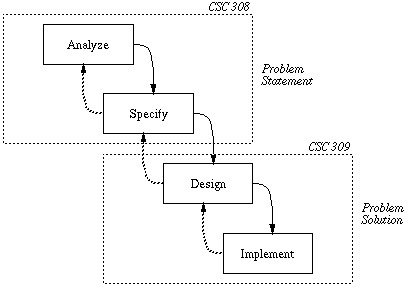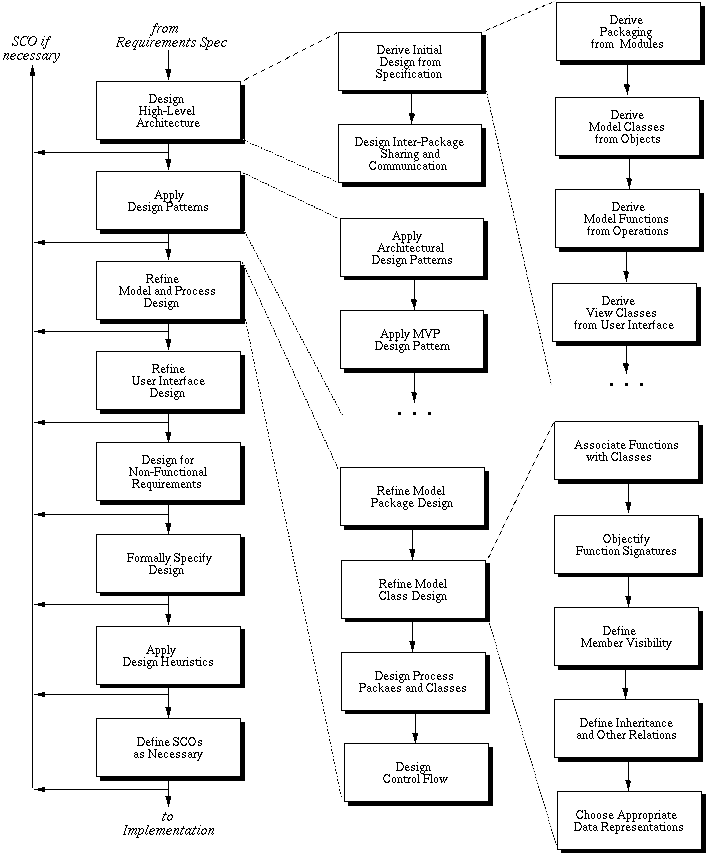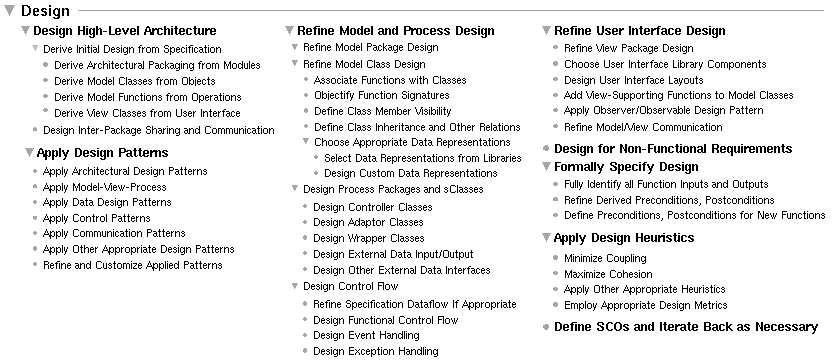-
Syllabus
-
Milestone 1, including,
-
SCO format
-
work breakdown format
- meeting minutes format
-
SCO format

Figure 1: Software system lifecyle.
-
Requirements Analysis determines what end users want and need from a
software system.
-
Specification formally defines user requirements.
-
Design defines and organizes the major operational components of the
system.
- Implementation defines operational details in a programming language.
-
The result of requirements analysis and specification is a document that
specifies what the system does as opposed to how it works.
-
In general, requirements analysis and specification are the domain of CSC 308.
-
This quarter we will work three selected requirements specifications from 308:
EClass, Grader, and TestTool.
-
You can choose to work on the same requirements specification you wrote last
quarter.
-
Alternatively, you can choose different spec from last quarter, a previous
quarter, or a combination of two or more specs.
- We will discuss details during the first week lab meetings.
- Links to the specs from last and previous quarters are located at:
http://www.csc.calpoly.edu/~gfisher/classes/309/specs -
You can choose to work on the same requirements specification you wrote last
quarter.
-
Adhere to the specification
-
Any deviation from the specification must be recorded and approved in a
Specification Change Order (SCO).
-
The specification plus SCOs form a binding contract between the
customer and the design team.
- No changes to specification can be made without consulting with the customer and completing a signed SCO.
-
Any deviation from the specification must be recorded and approved in a
Specification Change Order (SCO).
-
Achieve design quality goals:
-
Traceability -- elements of the design trace back to corresponding
elements of the specification.
-
Modularity -- elements of the design are organized into logically
cohesive modules.
-
Portability -- the design is sufficiently general that it can be
implemented on a variety of platforms and a variety of (related) programming
languages.
-
Maintainability -- the system is designed such that it can be easily
repaired and enhanced.
- Reusability -- where appropriate, modules are designed to promote their reuse in other (future) designs.
-
Traceability -- elements of the design trace back to corresponding
elements of the specification.

Figure 2: The 309 design process.
and 3).

Figure 3: Design Process Fully Expanded.
-
Design High-Level Architecture.
-
The step starts by deriving the high-level architecture of the program from the
requirements model constructed in the Specify
step.
-
The modularization defined for the structural model is carried forward into the
packaging of the program design.
- This enforces traceability between the abstract specification and the corresponding architectural program design.
-
The modularization defined for the structural model is carried forward into the
packaging of the program design.
-
The high level architecture of a program is defined in terms of data classes
and computational functions.
-
These are derived, respectively, from the objects and operations of the
abstract requirements model.
-
The program classes and functions derived directly from the requirements model
constitute the model portion of the design.
- The program classes derived directly from concrete user interface are the view portion of the design.
-
These are derived, respectively, from the objects and operations of the
abstract requirements model.
-
The step starts by deriving the high-level architecture of the program from the
requirements model constructed in the Specify
step.
-
Apply Design Patterns.
-
Once the top-level design elements are derived from the requirements
specification, software design patterns are applied.
-
A design pattern is a pre-packaged piece of design, based on experience that
has been gained over the years by software engineers.
-
High level design patterns can be used to improve the software architecture,
which entails how the major software components relate to one another and
communicate.
-
A widely-used design pattern for end-user software is Model-View-
Process (MVP).
-
The MVP pattern organizes the design into three major segments:
-
the Model is directly traceable to the abstract functionality defined
in the requirements model, and is independent of the concrete end-user
interface;
-
the View segment of the design is devoted specifically and solely to
the end-user interface
- the Process segment defines underlying processing support for the model, in particular processing that encapsulates platform-dependent aspects of the design.
-
the Model is directly traceable to the abstract functionality defined
in the requirements model, and is independent of the concrete end-user
interface;
- Other patterns are employed to assist with design of program data, control, and communication.
-
Once the top-level design elements are derived from the requirements
specification, software design patterns are applied.
-
Refine Model and Process Design.
-
The derived, pattern-based design produced by the first two steps must be
refined into a concrete, object-oriented program design.
-
Model package design is refined using object-oriented design principles,
information hiding conventions, and other design guidelines.
-
Derived functions must be associated with specific model classes, along with
other class refinements.
-
The function-assignment step is necessary because the operations of the
functional specification do not necessarily belong to specific objects.
-
In terms of typical nomenclature, functions associated with classes become
class methods, with appropriate adjustment to method signatures based
on object-oriented design concepts.
-
Other necessary design refinements are in the areas of class member visibility,
inheritance, and the selection of concrete data representations.
- In a modern program design, data representations are typically selected from reusable program libraries.
-
The function-assignment step is necessary because the operations of the
functional specification do not necessarily belong to specific objects.
-
Process class design entails determining the underlying processing support that
is necessary to produce an efficient program.
-
To encapsulate platform-dependent data processing, process classes are
interfaced with model classes via controller, adaptor, and wrapper classes.
- These model/process interface classes encapsulate aspects of the program that are specific to specific operating systems, hardware platforms, and external data stores.
-
To encapsulate platform-dependent data processing, process classes are
interfaced with model classes via controller, adaptor, and wrapper classes.
-
An important part of model and process refinement is detailed control flow
design.
-
Dataflow relationships defined in the specification are refined into concrete
procedural or multi-process control flow
- Other important aspects of control-flow design are functional control flow, event handling, and exception handling.
-
Dataflow relationships defined in the specification are refined into concrete
procedural or multi-process control flow
-
The derived, pattern-based design produced by the first two steps must be
refined into a concrete, object-oriented program design.
-
Refine User Interface Design.
-
The fourth step of design is devoted to refining the end-user interface.
-
In the current state of the art, user interface design typically relies heavily
on libraries of reusable interface classes.
-
The class libraries define commonly-used interface elements and layouts.
-
In a Model-View design, the model classes must be refined to support the view
classes, based on the specifics of the user interface.
-
A particularly useful design pattern in this regard is called the
"Observer/Observable" pattern.
- This pattern defines the way in which view classes can be systematically updated in response to changes made by the user to data values stored in the model classes.
-
The fourth step of design is devoted to refining the end-user interface.
-
Design for Non-Functional Requirements
-
Any non-functional requirements that were not modeled in the specification or
are not yet incorporated in the design are dealt with in this step.
- The purpose of this step is to ensure that all system-related non-functional requirements are fully addressed in the design.
-
Any non-functional requirements that were not modeled in the specification or
are not yet incorporated in the design are dealt with in this step.
-
Formally Specify Design.
-
As the detailed program design is established, the design is formally
specified.
-
This entails the precise definition of function (i.e., method) input/output
signatures, followed by the specification of preconditions and postconditions
for all functions.
-
For the model functions derived directly from the specification, the function
conditions are derived directly from the preconditions and postconditions
defined in the derived-from operations.
-
For other model and process functions, preconditions and postconditions are
defined with the same methodology used in the abstract specification model.
- Namely, preconditions are expressions that must be true before function invocation; postconditions must be true after function executions.
-
As the detailed program design is established, the design is formally
specified.
-
Apply Design Heuristics.
-
Various design heuristics (i.e., general guidelines) can be applied throughout
the process of design.
-
Minimizing coupling among program elements aims to reduce the dependency and
communication to only that which is essential
-
Maximizing cohesion means that program elements that are functionally related
are grouped together, without extraneous unrelated elements.
- Other heuristics can be applied, such as controlling the size of various program components.
-
Various design heuristics (i.e., general guidelines) can be applied throughout
the process of design.
-
Define SCOs and Iterate Back as Necessary.
-
During the course of program design, the developer may discover aspects of the
requirements specification that need to be modified or enhanced.
-
In such cases, the designer defines a specification change order that
clearly states the necessary modifications or enhancements.
-
This formalized change order is in keeping with the high-level process
decomposition into problem definition and problem solution phases.
-
As discussed above, the Analyze and Specify process steps comprise the problem definition
phase.
- The Design and Implement steps then comprise the problem solution phase.
-
As discussed above, the Analyze and Specify process steps comprise the problem definition
phase.
-
In this software process, as in a traditional problem-solving process, changing
the problem definition while the solution is underway requires careful
consideration.
- The specification change order codifies this careful consideration in a precise way.
-
During the course of program design, the developer may discover aspects of the
requirements specification that need to be modified or enhanced.
-
The process employs techniques from a number of design methodologies,
including:
-
The UML (unified modeling language) of Rumbaugh, et al.
-
The structured design techniques of Yourdon, et al.
- The MVP (Model-View-Process) technique (aka, MVC -- Model-View-Controller), used originally with the Smalltalk language, and now used extensively in Java designs.
-
The UML (unified modeling language) of Rumbaugh, et al.
-
The process works well for information processing systems with substantial end-
user interfaces, which are the types of systems developed in 308 and 309.
-
For other types of system, similar process steps can be used, but possibly in a
different order, and with different domain-specific methodologies.
-
Other major system types include:
-
Realtime systems, such as communications software.
-
Utility systems, such as compilers and operating systems.
- Embedded systems, such as device drivers and process controllers.
-
Realtime systems, such as communications software.
-
One of the problems to be confronted in designing from a formal specification
is the translation from the requirements/specification language into the
design/implementation language.
-
In some cases, specification languages may differ from programming languages,
since there are different forces influencing the design of the two types of
languages.
-
In the case of specs written in Fall 2012, the specs are written in a subset of
Java, which is the same as the 309 design and implementation language.
-
Specs from past quarters of 308 used a modeling language different from Java.
-
The data dictionary generated from the formal specification can be useful, but
you are not expected to read or understand the compilable model code.
- If you use requirements from previous quarters, you'll need to generate the Java model from scratch, but this should not be an overly difficult task.
-
In the case of specs written in Fall 2012, the specs are written in a subset of
Java, which is the same as the 309 design and implementation language.
-
See the writeup.
- We'll go over key points in class.